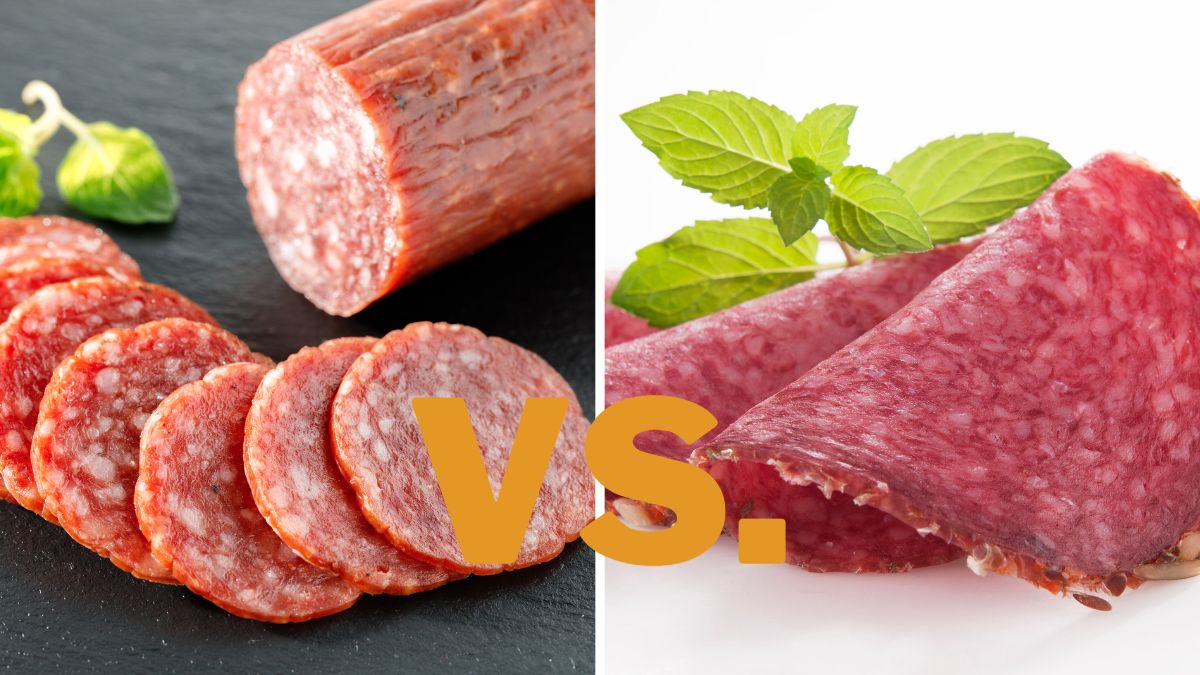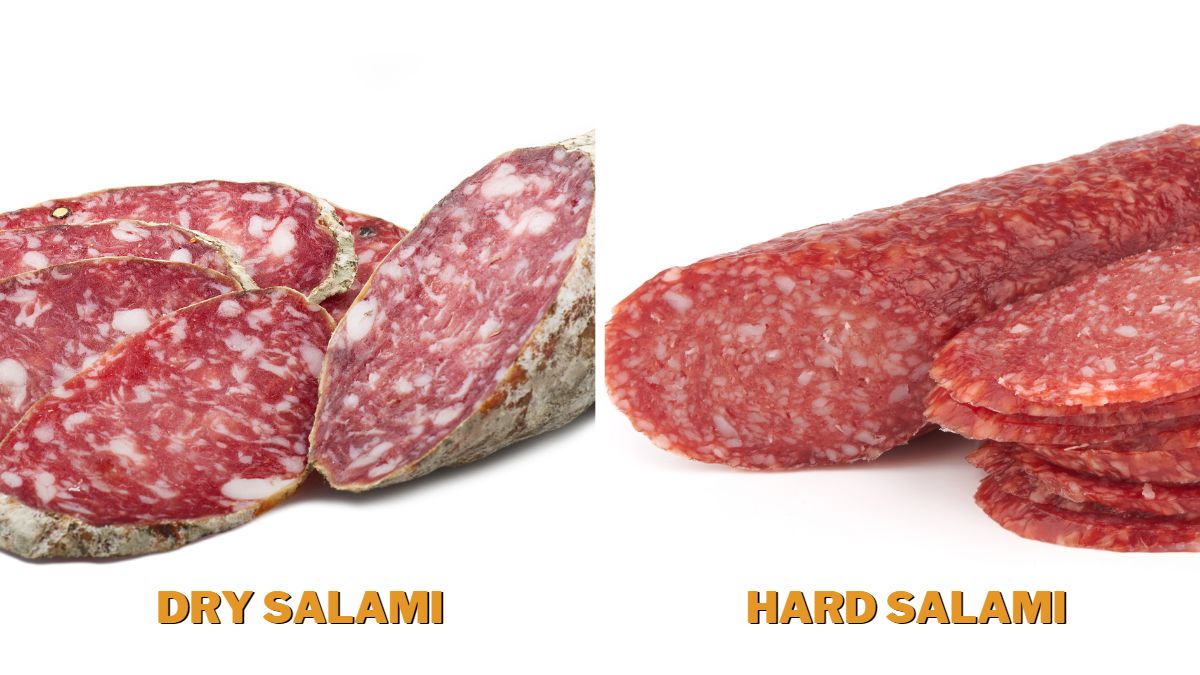Dry Salami vs. Hard Salami: Differences & Which Is Better?

Curing and drying meats to preserve them has been a centuries-old tradition, and salami is no different. My grandma used to tell me stories about the meat-curing process — she used to live in a rural area, and her parents raised cattle for a living. And salami was her favorite product, so she would always correct me when I called one the wrong name. Trust me, I know how confusing it can get. So, it’s only natural to wonder, “What is the difference between dry and hard salami?”
Believe it or not, dry and hard salami mean the same thing. Hard salami has a higher meat-to-fat ratio, resulting in a harder and dryer end product that looks darker than other salami.
Now that we know what we’re talking about, let’s examine these two in more detail to learn more about their characteristics and uses!
Are Dry Salami and Hard Salami the Same Thing?
Dry salami and hard salami are the same, with the only difference being how they’re used when talking about the cured meat in detail. Most vendors refer to the product as “hard salami” because of how it feels when handled, while those who eat it might describe the portion as “dry salami.”
So why the difference in usage when they mean the same thing? That’s because “dry salami” is more of a descriptive phrase. Due to the lower fat content of hard salami, they can be chewy and dry — hence the term.
To find out what makes hard salami “dry” and dry salami “hard,” let’s look at how it’s made in detail.
Origin
Unlike name salami varieties such as Genoa salami, hard salami’s origins can be hard to pinpoint. The consensus is that hard salami originated in Central Europe, likely around Germany and Poland. That region smoked their meats instead of soaking them in wine like in Italy.
Ingredients
Most hard salami still contain pork but with less fat than their “wet” counterparts. You’ll also commonly see mixtures of beef and other meats such as venison or horse.
As far as seasoning goes, hard salami still contains the usual ingredients of peppercorn and garlic. However, they may be more muted to not interfere with the flavors imparted by smoking. It’s also missing the signature tang of other softer salami since it doesn’t have wine.
Production
Depending on your naming preference, hard salami or dry salami is made the same way as their “wet” counterparts. Like Genoa salami, hard salami consists of meat and seasoning that’s stuffed into a casing, and then smoked.
Of course, the main difference is the sausage’s taste after it’s been smoked. Because hard salami doesn’t have wine, you get more of the “smokey” flavor. You won’t experience this with wet salami.
Texture
Because hard salami typically contains leaner meat than the other types, some people describe hard salami as “chewy.” Dry salami is also not as greasy, hence “dry.” Lastly, because the meat mixture didn’t get any extra moisture from additives such as wine, the sausage itself is firmer.

Taste
Discussing hard salami makes no sense if we don’t talk about the taste as well. After all, what good is a sausage that isn’t eaten?
Hard salami tends to be chewy and firm because of its lower moisture and fat content. It also has a more pungent smoked taste because it didn’t have any wine to alter its flavor. The result is a bold, robust salami that shines with a peppery, smoky profile. It can stand on its own or with cheeses that complement its assertive flavor.
How Do You Eat Dry Salami?
The recommended way of serving salami is to slice it thinly and lay it on your plate or sandwich. Afterward, store the rest of the sausage in the refrigerator for up to three weeks. I sometimes simply bite into it, so if you’re feeling primal and want to take a massive bite out of the sausage, you can do that too.
How you eat dry salami depends on your preference at that moment. Do you feel like snacking on a few thin slices alone or perhaps with some crackers and cheese? Or do you feel like putting together a sandwich with some salami slices and spots of cheese?
The beauty of dry salami is that you can eat it however you like. Even though it has a bolder flavor, it’s not as assertive. You can pair it with just about anything, and it will still work well. You don’t have to stick to milder cheeses for fear of clashing flavors, as you would with wet salami variants.

Can You Substitute Hard Salami With Another Salami?
You’re always free to substitute hard salami with another, but what you pick will depend on your preferences. If you’re not bothered with the kind of salami you’re using and just want to enjoy some Italian sausage, then something like a soppressata or finocchiona is your best bet. It’s as close to an Italian dry salami as you can get.
But if you prefer something as dry and lean as a dry salami, you might have to look outside the salami world and into the realm of dry, smoked sausages. You’ll have to experiment with other types, such as chorizo, to find out which one you like.
Which Is Better, Dry Salami or Hard Salami?
Remember that dry and hard salami is the same. Hard salami is hard because of its lower fat content and the omission of wine in the curing process; dry salami is the term used for any smoked, cured sausage that isn’t as fatty or greasy to the touch. Basically, the two are general descriptions that describe the same thing.
With that in mind, a dry, hard salami can be good if you’re not expecting something soft. Hard salami pairs well with wine and cheese because of its peppery and smoky flavor and also works well as a sandwich. Unleash your creativity and experiment with your dry salami pairings; you might be surprised at the results.
But if you’re wondering whether a wet salami is better than a dry salami, then the wet salami might just edge the dry salami a tiny bit. Wet salami isn’t as hard to chew as its dry counterparts, so more people can enjoy a slice or two. The type of wine used and the fat content also change the flavor profile.
Final Thoughts
Don’t be confused with dry and hard salami. Remember that they refer to the same lean, smoked sausage. They might not be as soft as the other salami you’re used to, but that doesn’t mean you should pass on hard salami.
Instead, you should give it a try if you haven’t yet. Grab yourself a nice wedge of cheese and maybe some crackers. Take a few slices of hard salami with you, and you’ll be surprised at how different they can be while providing the same deliciousness level as the wet varieties.
What would you put on your salami board next to dry/hard salami? I would love to read your recommendations in the comments below!
